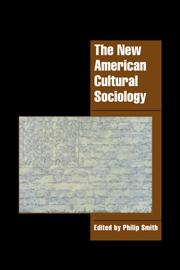Book contents
- Frontmatter
- Contents
- Notes on contributors
- Preface
- The new American cultural sociology: an introduction
- PART I Culture as text and code
- PART II The production and reception of culture
- PART III Culture in action
- 11 Culture and social action
- 12 Culture, structure, agency, and transformation
- 13 Discourse, nuclear power, and collective action
- 14 Moral boundaries, leisure activities, and justifying fun
- 15 Honor and conflict management in corporate life
- 16 The role of cultural capital in school success
- Index
- Title in this Series
12 - Culture, structure, agency, and transformation
Published online by Cambridge University Press: 18 January 2010
- Frontmatter
- Contents
- Notes on contributors
- Preface
- The new American cultural sociology: an introduction
- PART I Culture as text and code
- PART II The production and reception of culture
- PART III Culture in action
- 11 Culture and social action
- 12 Culture, structure, agency, and transformation
- 13 Discourse, nuclear power, and collective action
- 14 Moral boundaries, leisure activities, and justifying fun
- 15 Honor and conflict management in corporate life
- 16 The role of cultural capital in school success
- Index
- Title in this Series
Summary
“Structure” is one of the most important and most elusive terms in the vocabulary of current social science. The concept is central not only in such eponymous schools as structural functionalism, structuralism, and post-structuralism, but in virtually all tendencies of social scientific thought. But if social scientists find it impossible to do without the term “structure,” we also find it nearly impossible to define it adequately. Many of us have surely had the experience of being asked by a “naïve” student what we mean by structure, and then finding it embarrassingly difficult to define the term without using the word “structure” or one of its variants in its own definition. Sometimes we find what seems to be an acceptable synonym – for example, “pattern” – but all such synonyms lack the original's rhetorical force. When it comes to indicating that a relation is powerful or important it is certainly more convincing to designate it as “structural” than as “patterning.”
Three problems with the concept of structure
There are, nevertheless, three problems in the current use of the term that make self-conscious theorizing about the meanings of structure seem worthwhile. The most fundamental problem is that structural or structuralist arguments tend to assume a far too rigid causal determinism in social life. Those features of social existence denominated as structures tend to be reified and treated as primary, hard, and immutable, like the girders of a building, while the events or social processes they structure tend to be seen as secondary and superficial, like the outer “skin” of a skyscraper, or as mutable within “hard” structural constraints, like the layout of offices on floors defined by a skeleton of girders.
- Type
- Chapter
- Information
- The New American Cultural Sociology , pp. 188 - 201Publisher: Cambridge University PressPrint publication year: 1998
- 2
- Cited by



